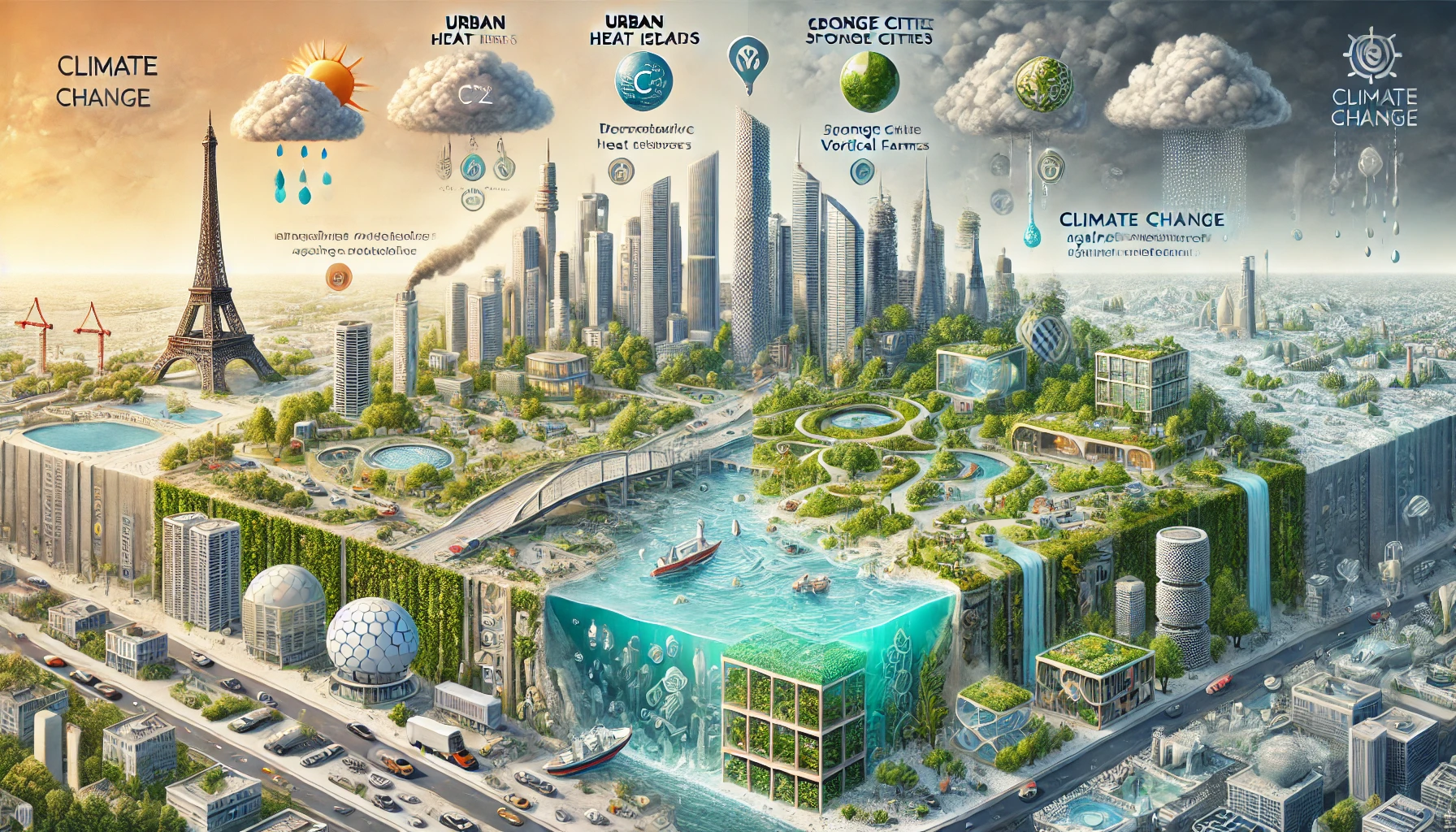
Challenging the Mainstream Narrative on Anthropogenic Climate Change: A Scholarly Review
Introduction
The discourse on anthropogenic climate change (ACC) has dominated scientific, political, and public agendas worldwide. The mainstream narrative posits that human activities, notably fossil fuel combustion and industrial emissions, are significantly accelerating climate change through greenhouse gas emissions, resulting in global warming, rising sea levels, and increased natural disasters. However, a non-mainstream discourse challenges this narrative, questioning the validity of data sources, the proportion of human impact relative to natural processes, and whether climate change is as much an urban planning issue as it is an environmental one. This article examines key arguments that challenge the mainstream view on ACC and explores alternative urban design approaches that may enhance resilience to climate-related challenges.
Data Skew from Urbanized Weather Stations
One significant criticism from skeptics of the mainstream ACC narrative concerns data collection methods, particularly those related to surface temperature measurements. Numerous weather stations, originally located in rural areas, have become encircled by urban sprawl, which alters the microclimate around these stations, leading to the “urban heat island effect” (UHI) (McKitrick & Michaels, 2007). Urban areas, characterized by extensive concrete and asphalt, absorb more heat than rural areas, artificially inflating recorded temperatures. This effect suggests that reported global warming trends may be, in part, an artifact of urbanization rather than an accurate reflection of global atmospheric changes (Christy, 2019). Studies indicate that UHI could account for a measurable percentage of observed temperature increases, calling into question whether all warming attributed to human activity is accurately depicted (McKitrick, 2010).
Sea Level Stagnation: Evidence Against Rising Oceans
Predictions of significant sea-level rise have fueled concerns about climate change’s impact on coastal populations and ecosystems. However, despite predictions dating back to the 1990s, there has been little evidence of drastic sea-level change in many regions (Morner, 2007). Non-mainstream scientists argue that, while local factors such as land subsidence or tectonic shifts have caused varied sea levels, global sea-level rise has remained relatively modest. Satellites and tide gauges reveal a consistent but small rate of rise over the past century, challenging claims that low-lying areas will soon be submerged (Nerem et al., 2018). Critics argue that rising sea levels have often been exaggerated for political or financial motivations and suggest focusing on localized issues, such as land management, rather than global mitigation measures.
Human Versus Natural Greenhouse Gas Contributions
Another argument posed by non-mainstream voices is the proportionality of human-generated greenhouse gases relative to natural emissions. While human activities release carbon dioxide (CO₂) and other greenhouse gases, skeptics argue that these contributions are minimal compared to natural emissions. For instance, natural processes, such as volcanic activity, ocean outgassing, and plant respiration, contribute to atmospheric CO₂. In contrast, anthropogenic sources account for only a fraction of the total carbon cycle, with estimates ranging between 3-5% of total CO₂ emissions (IPCC, 2021). Skeptics claim that natural feedback systems, like oceanic absorption and increased plant growth, have counterbalanced human emissions, suggesting that current climate change trends might not be as human-driven as suggested by the mainstream narrative (Harde, 2014).
Urbanization and the Local Climate Impact
The issue of urban design and its impact on local climates is also highlighted in the alternative discourse on climate change. Skeptics propose that much of the observed environmental change attributed to ACC could result from urban development that has failed to consider ecological resilience. Cities are predominantly constructed with impermeable surfaces, exacerbating heat retention, air pollution, and flood vulnerability (Gill et al., 2007). In the absence of green infrastructure, cities are poorly equipped to handle increasing precipitation, leading to urban flooding that could be mitigated through better planning rather than global emissions reduction.
Futuristic Urban Design: Resilience and Adaptation
As a forward-thinking approach, critics of the mainstream ACC narrative advocate for urban design reforms that emphasize resilience and adaptation over mitigation. The concept of “sponge cities,” for example, proposes a sustainable urban design that focuses on water absorption and retention (Wang et al., 2018). By integrating green roofs, permeable pavements, and natural waterways, these cities can reduce urban flooding and heat while restoring biodiversity. Another example is “vertical farming” within cities, where agriculture is conducted indoors, reducing the need for extensive rural land and curbing transportation emissions (Despommier, 2011). These designs challenge traditional urban layouts and present sustainable alternatives that, while minimizing ACC’s local effects, also address immediate environmental issues without relying on global consensus.
Conclusion
The non-mainstream discourse on climate change raises essential questions about the complexity of climate systems, the reliability of data, and the effectiveness of proposed mitigation strategies. While the mainstream narrative focuses on global emission reductions, the alternative view suggests that local interventions in urban design may offer immediate and practical solutions to environmental challenges. Implementing resilient infrastructure, promoting sustainable urban design, and acknowledging natural climate variability could diversify strategies for addressing climate change, potentially offering more tailored and impactful responses. Ultimately, embracing a broader discourse on climate science and urban resilience may lead to a more nuanced understanding of human-environment interactions and foster innovative solutions to both global and local environmental challenges.
References
Christy, J. R. (2019). Testimony of John R. Christy, University of Alabama in Huntsville, before the Committee on Science, Space and Technology. U.S. House of Representatives.
Despommier, D. (2011). The vertical farm: Feeding the world in the 21st century. Macmillan.
Gill, S. E., Handley, J. F., Ennos, A. R., & Pauleit, S. (2007). Adapting cities for climate change: The role of the green infrastructure. Built Environment, 33(1), 115-133.
Harde, H. (2014). Advanced two-layer climate model for the assessment of global warming by CO2. Open Journal of Atmospheric and Climate Change, 1(2), 1-50.
Intergovernmental Panel on Climate Change (IPCC). (2021). Climate change 2021: The physical science basis. Cambridge University Press.
McKitrick, R. R. (2010). Atmospheric land surface temperature trends from 1979 to 2008. Journal of Geophysical Research: Atmospheres, 115(D14).
McKitrick, R. R., & Michaels, P. J. (2007). Quantifying the influence of anthropogenic surface processes and inhomogeneities on gridded global climate data. Journal of Geophysical Research: Atmospheres, 112(D24).
Morner, N. A. (2007). Sea level changes and tsunamis, environmental stress and migration overseas. Internationales Asien Forum, 38(3-4), 353-374.
Nerem, R. S., Beckley, B. D., Fasullo, J. T., Hamlington, B. D., Masters, D., & Mitchum, G. T. (2018). Climate-change–driven accelerated sea-level rise detected in the altimeter era. Proceedings of the National Academy of Sciences, 115(9), 2022-2025.
Wang, Y., Li, Q., & Ye, Y. (2018). Sponge city planning for addressing urban waterlogging under changing climate. Water, 10(8), 1040.



